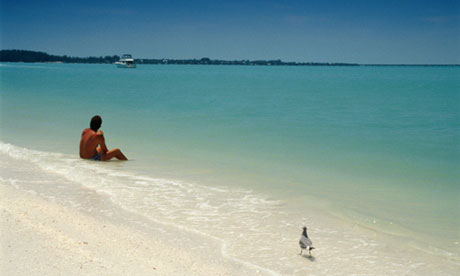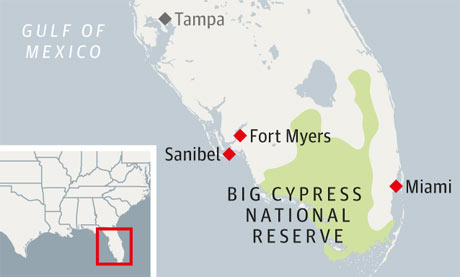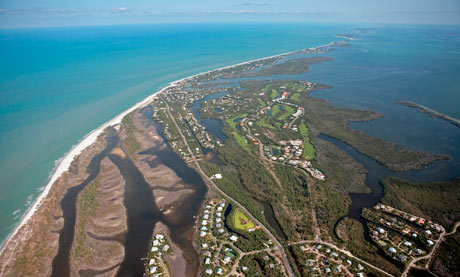Friday 5 April 2013 16.00 EDT
Andrew Mueller
Sanibel: Florida's haven of tranquility
http://m.guardiannews.com/travel/2013/apr/05/sanibel-florida-seashell-haven-tranquillity
Florida's Sanibel island may not offer much more than seashells on its shores but that's why the US destination is so special
Every tide that hits Sanibel is like the upending of a treasure chest. In the morning, the blindingly white beaches of this island off Florida's Gulf coast twinkle with the bounty deposited overnight: a kaleidoscopic shimmer of seashells, in quantities that almost obscure the sand, in sizes from the too small to notice to the big enough to trip over, in such colours that you start to suspect molluscs, as a species, of being outrageous showoffs.
It's impossible to develop a comprehensive familiarity with this trove in just a few days, but you can learn enough to tell your angulate wentletrap from your purplish semele, your ponderous ark from your prickly cockle (seashells, for reasons escaping my research, all seem to be named after Victorian euphemisms for venereal disease).
You need to tread carefully, as many of these baubles have sharp spikes, and be even warier about picking things up, as quite a few of them are still inhabited by their original owners, or by hermit crabs, the squatters of the deep. There is manifold competition for Sanibel's daily jackpot. The beach is an all-you-can-eat buffet for assorted wader birds, and a motherlode for shell collectors.
The latter species present a curious spectacle, hunched intently and fossicking, resembling a herd of human throwbacks who've regressed to the quadrupedal. After a few days on Sanibel, though, you can understand their single-mindedness, and even their reasons for being up this early. It's partly that the shells are beautiful, but it's also that – and this is not intended as any sort of slight upon Sanibel – there really isn't much else to do.
Among the few road signs on Sanibel is one which cautions drivers to watch out for tortoises. This is a place which prides itself on its sleepiness, to the extent that several locals think it worth pointing out the branch of ice-cream chain Dairy Queen which, they boast, is the only franchise outlet on the island. It isn't, quite: there's a small Subway, and a cafe that sells Starbucks coffee, but my guides' reluctance to acknowledge these seems significant.
The view of the rest of Florida from Sanibel is not unlike the view of continental Europe from Britain. From both island redoubts, the bigger place across the water is regarded as peculiar, its inhabitants excitable, its traditions undignified. Were it not for the Florida plates on cars, and the almost tiresomely pleasant weather, a mystery tourist relieved of their blindfold on arrival could assume themselves to be in Vermont, or Maine, or some similar cosy north-eastern haven of sandal-shod muesli-eaters. At least until they see the shop window sign offering alligator heads at $200 each.
These artefacts are, however, almost intriguingly unrepresentative of Sanibel's generally ardent conservationist ethos. More than 6,400 acres of Sanibel is the Ding Darling national wildlife refuge, named after Jay Norwood Darling, the early 20th-century Pulitzer-winning newspaper cartoonist who campaigned to protect Sanibel from developers.
An admirable establishment called the Clinic for the Rehabilitation of Wildlife rescues and treats injured creatures. Crow treats 4,000 animals annually, and while their patients are quite properly not permitted visitors, its public education centre is worth a look, especially if you were previously unaware that acupuncture can be employed to treat tortoises.
The cute, furry contingent of Sanibel's fauna are either vexingly nocturnal (bobcats) or dead (raccoons, which have been severely affected by a recent outbreak of distemper), but there's plenty more to see, especially on the four-mile Wildlife Drive, which meanders through mangrove forest.
The spectacles are mostly of the avian sort: osprey, cormorant, egret, heron, anhinga, pelican. Impressive though these are, they're somewhat lost on me, as among them are ducks, and almost nothing amuses me as much as ducks, as a result of their air of lofty querulousness, coupled with the lack of things a duck could possibly have to be loftily querulous about. There's also an alligator: – a big one for Sanibel, I'm told, six feet of semi-submerged armour-plated death machine drifting downriver. And, less excitingly, the island is plagued with voracious mosquitoes.
Inevitably, Sanibel's best-known selling point is for sale at shops all over the island (just as inevitably, the biggest such emporium is called She Sells Sea Shells.) The most sensational collection is at the Bailey-Matthews Shell Museum on Captiva Road on the island's north side. According to its brochure, this is the "most comprehensive museum in the western hemisphere devoted solely to shells". It seems churlish to ask how rugged the competition for this title is.
It, assiduously curated by local volunteers, contains much that is thought-provoking and astonishing, including an examination of the scallop's influence on art and architecture, a caseful of Cuban bush snails which resemble boiled sweets, and some of the largest shells ever recovered, including a lightning whelk 40cm long, among them a two-foot-long triplofusus giganteus or horse conch, found off Sanibel. (Conch, a staple of Sanibel restaurants, is apparently pronounced "conk", as waitng staff take unnecessary delight in reminding you.) There are also examples of efforts to be creative with shells, which serve to reinforce the lesson already imparted by Sanibel's souvenir shops: that while shells themselves are beautiful, every human attempt to co-opt them is hideous.
Sanibel's cultivated placidity could become overwhelming. If that is the case, it is conveniently hitched by bridge to Captiva, a smaller, less staid island that offers such vulgar pursuits as nightlife, and ferry cruises that get mildly harassed by gambolling dolphins. And if that isn't enough, more traditional Florida recreations of drinking, gambling and communicating in a vocabulary consisting largely of the expression "whoooo!" are only a 20-minutes drive away, at Fort Myers Beach, on the other end of Causeway Boulevard.
Despite such temptations, Sanibel is a difficult place to leave. It offers two valuable commodities that may be obviously unusual in Florida but can be difficult to find in holiday destinations anywhere: peace and quiet.
------------------------------------------------
Visit Reservation Central Sanibel Island and Captiva Island today to plan your next Sanibel Island or Captiva Island vacation! Local accommodation specialists available by phone at 1-800-290-6920 / 239-472-1010 and always available online at http://www.ResCen.com
Tuesday, April 9, 2013
Monday, April 1, 2013
10Best Goes to Sanibel Island, Florida
http://www.10best.com/interests/beaches/10best-goes-to-sanibel-island-florida/
Sanibel Island - Paradise Close to Home
Sanibel Island, located off the coast of Southwest Florida near Fort Myers, offer an idyllic, lush subtropical getaway without having to leave the country. With a permanent population of only 6,500 and 15 square miles of unspoiled beach, you'll have no trouble finding your own quiet slide of paradise to relax in.
Sanibel Island - Paradise Close to Home
Sanibel Island, located off the coast of Southwest Florida near Fort Myers, offer an idyllic, lush subtropical getaway without having to leave the country. With a permanent population of only 6,500 and 15 square miles of unspoiled beach, you'll have no trouble finding your own quiet slide of paradise to relax in.
Visit Reservation Central Sanibel and Captiva Islands to make your next Island Vacation. On the web at www.rescen.com or call a local accommodation specialist at 1-800-290-6920
Subscribe to:
Posts (Atom)




